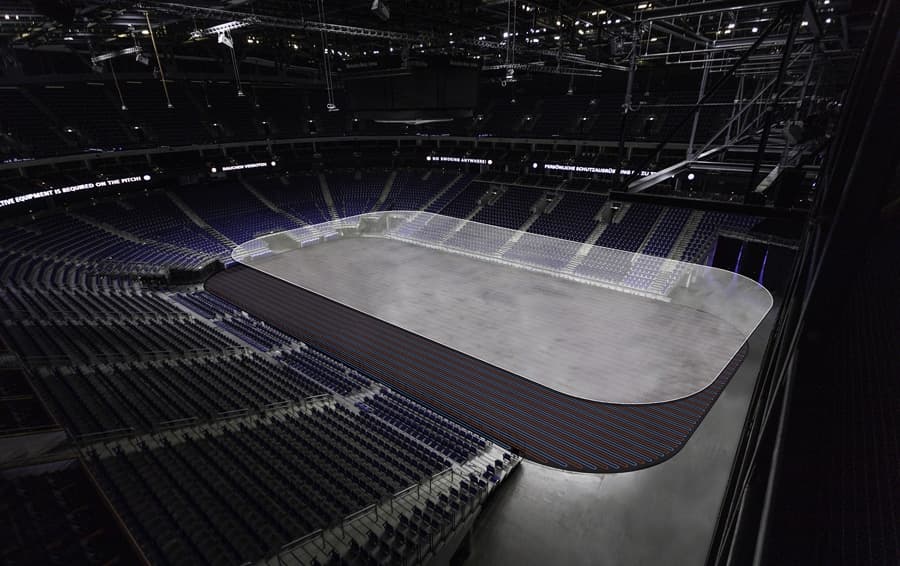An icy cold for the Eisbären rink – and pleasant temperatures for the fans in the stands: When the Eisbären Berlin aces in Germany’s top ice hockey league and their opponents from Germany and abroad go head to head on the ice, the frozen surface needs to keep pace. Especially when the heat is on in Berlin’s 17,000-seat multi-purpose Arena in Berlin and the strain on the ice surface intensifies by the minute. GEA cooling technologies – or, more precisely, GEA’s Grasso M compressor packages – have triumphed in the battle for the best ice.
Comfortable temperatures even off the ice
The climate also needs to be right in the stands. GEA technology ensures a pleasant temperature of up to 21 degrees Celsius for the fans. And because the next game or another major event is never far away, the ice needs to hold up and must not thaw. After an ice hockey game, construction usually starts right away to set up for a concert, a basketball game or other events. The ice surface then disappears under 1,249 insulation panels for several hours or even days without thawing or deteriorating in quality. This is possible thanks to a real power-play combination provided by engineers, ice masters and the in-house technicians team.
Efficiency of GEA technology tips the scales
CLIMATIC GfKK – Gesellschaft für Kältetechnik-Klimatechnik mbH was the main contractor for the multi-purpose arena project in Berlin. Technical Service Manager Martin Reichmuth explains the decision to go with GEA solutions and technologies: “It was the equipment’s efficiency that tipped the scales in GEA’s favor. The overall efficiency, flexibility, wide performance range, long service intervals and an extended, best-in-class warranty led to our selection.”
How to make the ice in the Berlin Arena a success: preparing the surface as an important basis
But how do the ice masters get the icy surface to fit precisely and on time? Since the championship in Germany’s top ice hockey league, the DEL, usually begins in September each year, the preparatory work starts in mid-August. The complex process, involving numerous steps, takes almost a week.
First, the concrete floor of the arena is prepared. This includes accurately measuring and marking the area as well as cleaning and smoothing the concrete surface to create a level base. Any irregularities or dirt particles must be removed to allow for even ice formation.
The Berlin arena refrigeration system works along the same principle as a refrigerator
Today’s refrigeration systems are based on the principle of a closed refrigeration cycle. An NH₃/CO2 (ammonia/carbon dioxide) cascade is installed in the Berlin arena. The secondary refrigerant is CO2, while NH₃ is the refrigerant for the primary circuit. The refrigeration circuit’s main components are the compressor, the condenser, the expansion valve and the evaporator, the refrigerant pumps and the cooling tower.
First, the gaseous refrigerant is sucked in and compressed by the compressor, with the heat generated in this process being absorbed by the refrigerant. The heated refrigerant is fed into the condenser, where it cools down at constant pressure. In the process, the refrigerant condenses, becoming liquid. In the next step, the now liquid refrigerant reaches the expansion valve. Through this valve, the refrigerant expands to a low pressure level, thus reducing the temperature. In the final step, the refrigerant flows into the evaporator, where it is returned to a gaseous state. During this process, the heat required is extracted from the surrounding environment, which cools down as a result. So in fact, cold is not being made. It is simply the removal of heat. The refrigeration cycle then starts again with the transfer of the refrigerant into the compressor.
The interface of the two circuits is the evaporator/condenser, where the gaseous CO2, which comes from the CO2 separator, is liquefied and the liquid ammonia is evaporated. Pumps then feed the liquefied CO2 into the pipes (secondary circuit) in the ice surface, where it absorbs heat and returns to the separator partially vaporized. The two circuits work in tandem.
Then the “manual work” begins
The ice masters apply water mist using hoses fitted with fine nozzles. The sprayed water is degassed, as normal tap water – with the oxygen and carbon dioxide it contains – would lead to gas inclusions in the ice and negatively impact its subsequent quality. The hoarfrost on the concrete floor absorbs the degassed water and freezes into ice. This fine water mist is applied repeatedly over several days – ensuring each time that the water can be completely absorbed by the hoarfrost and thus freeze. A layer of ice gradually forms from the hoarfrost. Advertising foils, logos as well as the ice hockey lines and markings are applied between the layers. While these are then covered by a thin layer of ice, they naturally remain visible. At the end of the process, the ice cover is about three and a half centimeters thick, ideal for an ice hockey game. Ice hockey players need a very hard ice surface of minus eight degrees Celsius so that the puck really flies.
Successful power play by GEA, ice masters and engineers in battling it out for the best ice
15 Nov 23

An icy cold for the Eisbären rink – and pleasant temperatures for the fans in the stands: When the Eisbären Berlin aces in Germany’s top ice hockey league and their opponents from Germany and abroad go head to head on the ice, the frozen surface needs to keep pace. Especially